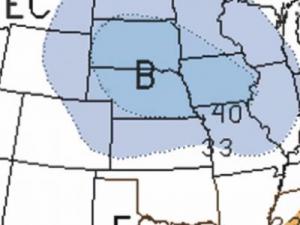Stressors and impacts
Myron Johnson, owner of Double J Farms in Alabama, takes a gamble every time he puts a crop in the ground. Until a crop is grown, harvested, and transported to market, his investments in land, seeds, and machinery are at risk from an array of climate- and weather-related events. In the high-stakes agricultural industry, he feels any strategy that increases his odds to bring a crop to market is worth considering.
Improving the odds
If Johnson knew ahead of time what conditions would be like during the next growing season, he could always make good decisions about what crops to grow and when to plant and harvest them. For example, if he knew the spring would be dry, he might plant a drought-resistant crop, or plant a little earlier than usual. If he knew the fall would be wet, he might arrange to have more equipment available so he could complete his harvest on days with no rain.
While meteorologists can’t yet make accurate weather predictions more than about 10 days into the future, climate scientists offer seasonal climate outlooks for temperature and precipitation, indicating regions’ chances for above-, within-, and below-average conditions for up to a year in advance. Climate outlooks are based on observed patterns in the ocean and atmosphere; using historical records, climate scientists check what kinds of weather conditions resulted from similar patterns in the past. For example, the presence of the climate pattern known as El Niño increases the chance for rainy winters in some regions. Outlook products also incorporate results from climate models, analyses of recent trends, and experts’ judgments.
Making decisions based on Climate Outlooks
When Johnson recognized a seasonal climate outlook with increased chances for conditions that would be conducive for growing wheat, he planted wheat, harvested a robust crop, and made a good profit. He’s also paid attention to climate outlooks when making decisions about growing cotton; he attributes part of the good cotton yields he’s seen to decisions he made after consulting seasonal forecasts.
Even with his successes, Johnson knows that climate outlooks don’t give him a “crystal ball” that can accurately predict future weather. When an outlook shows increased chances for conditions to be warmer, cooler, drier, or wetter than average, he knows that it doesn’t preclude the possibility of the exact opposite condition. And he knows growing crops are still vulnerable to specific weather events, such as late freezes and damaging hailstorms.
Though some seasonal outlooks turn out to be wrong, resulting in poor or even failed crops, Johnson feels that outlooks give him an added benefit over the long-term because they are based on probabilities. Anything that improves his odds over multiple years ultimately means a more stable future for his farm and his family. In the face of uncertainty in our variable and changing climate, Johnson still turns to seasonal climate outlooks to help him make business decisions. In the long run, he feels this strategy will increase his chances for bringing crops to market.


